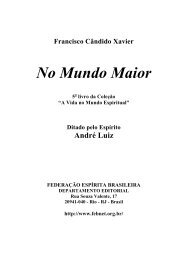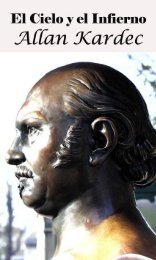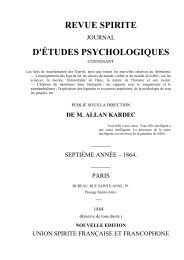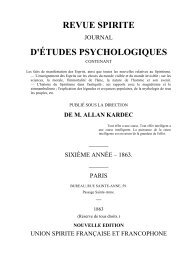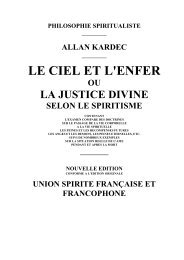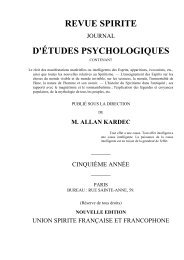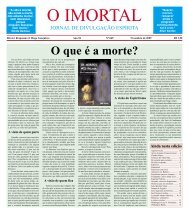PDF version - Geae
PDF version - Geae
PDF version - Geae
Create successful ePaper yourself
Turn your PDF publications into a flip-book with our unique Google optimized e-Paper software.
Returning to the origin of our race, we will see the idea of successive lives spread over the earth by the<br />
Gaul’s. It vibrates in the accents of the bards, it rings in the grand voices of the forests, saying, ‘I have stirred<br />
in a hundred worlds, I have moved in a hundred circles.’ It is the national tradition, and it inspired in our<br />
fathers disdain of death and heroism in combats. Arbois of Jubainville, Professor of the College of France,<br />
said, ‘In combats against the Romans, the Druids remained immobile as statues, receiving their wounds<br />
without fleeing or defending themselves. They knew themselves immortal, and counted on finding in another<br />
world a new and always young body.’ The Druids were not only brave men, but they were profoundly learned.<br />
Their cult was that of nature, celebrated under somber shades of great trees or temples built on cliffs. In the<br />
Triads they proclaimed the evolution of the soul climbing from the abyss, and slowly mounting the long spiral<br />
of existences, to attain, after many deaths and rebirths, the circle of felicity. The Triads are the most marvelous<br />
monuments which have been left to us concerning the antiquity and the wisdom of the Druids. They open up a<br />
perspective without limit to the astonished student.<br />
We recommend to our readers The Triads (19, 21, and 36) published by Ed. Williams from original<br />
Gaelic and translated by Edward Darydd. The Gaul’s taught reincarnation on earth, as well as on other spheres,<br />
as is demonstrated by A. de Jubainville in his course of Celtic literature. Find Mac Cumall, the celebrated Irish<br />
hero, is described as being killed at the battle of D’Athbrea in 273 A.D., and being reborn in 603, and later<br />
being king of Ireland. The author relates that the belief in reincarnation went back to ancient times of Ireland.<br />
Long before our era, Eochaid Airem, supreme king of Ireland, espoused Etain, daughter of Etar. Etain had<br />
several centuries before being born in Celtic lands as Ailill, wife of Mider, and she was deified after her death.<br />
The Celtic doctrine, after being lost for centuries, reappears in modern France, and has been<br />
reconstructed and sustained by a Pleiades of brilliant writers: Charles Bonnet, Dupont de Nemours, Ballanche,<br />
Jean Reynaud, Henri Martin, Pierre Laroux, Victor Hugo, Flammarion, etc.<br />
‘To be born, to die, to be reborn, and progress without cessation is the law,” as Allan Kardec has said.<br />
Thanks to him, and to the spiritual school of which he was the founder, the faith in successive lives of the soul<br />
spreads over the Occident, where it counts millions of partisans. The testimony of spirits has given it a definite<br />
sanction. With the exception of some undeveloped souls for whom the past is still enveloped in shadows, all<br />
the messages receive in our century affirm the plurality of existences and the indefinite progress of being.<br />
Earthly life, they say in substance, is but a preparation for life eternal. Limited to one existence in its<br />
ephemeral duration, the soul could not respond to so vast an object. Incarnations are the stations on the way of<br />
ascension - the mysterious ladder which, from obscure regions, by all forms and worlds, conducts us to the<br />
Kingdom of Light.<br />
Our existences unroll across the centuries. They pass, succeed one another, and begin anew: and with<br />
each one we leave a little of the evil which was in us. Slowly we advance and penetrate further in the sacred<br />
way, until we have acquired the merits which open an access for us to the superior circles from which shine<br />
eternally, beauty, wisdom, truth, and love.<br />
The attentive study of the history of people does not show us merely the universal character of this<br />
doctrine. It permits us also to follow the glorious chain of causes and effects in the social order.<br />
We see above all, that these effects are reborn of themselves, and return to their own principle; that<br />
they enclose individuals and nations in the network of a marvelous law. From this point of view the lessons of<br />
the past are compelling. The testimony of the centuries is painted in a majestic character which strikes the<br />
most indifferent mind, and demonstrates the irresistible force of right. All the evil accomplished, the blood<br />
spilled, the tears shed, fall sooner or later fatally upon their authors, individually or collectively. The same<br />
culpable acts, the same errors, lead to the same unfortunate consequences. While men persist in living hostile<br />
toward one another, to oppress, to fight, works of blood and mourning follow, and humanity suffers to the very<br />
depths of its being. There are expiations collective, as there are reparations individual. Through time an<br />
immense justice is exercised. It brings into bloom the elements of decadence and destruction, and the germ of<br />
death that the nations sow in their own breasts each time they violate higher laws. If we glance over the history<br />
of the world we will see that the youth of humanity, like that of the individual, has its periods of trouble and of<br />
sorrowful experiences. Across its pages unwinds a cortège of obligatory miseries. Profound depression<br />
alternates with high ecstasies - triumphs with defeat. Precarious civilization marked the first ages. The greatest<br />
empires crumpled one after another in the maelstrom of passions. Egypt, Nineveh, Babylon, the empires of<br />
Persia, are all fallen. Rome and Byzantine, eaten by corruption, went down under the force of barbarians.<br />
85



